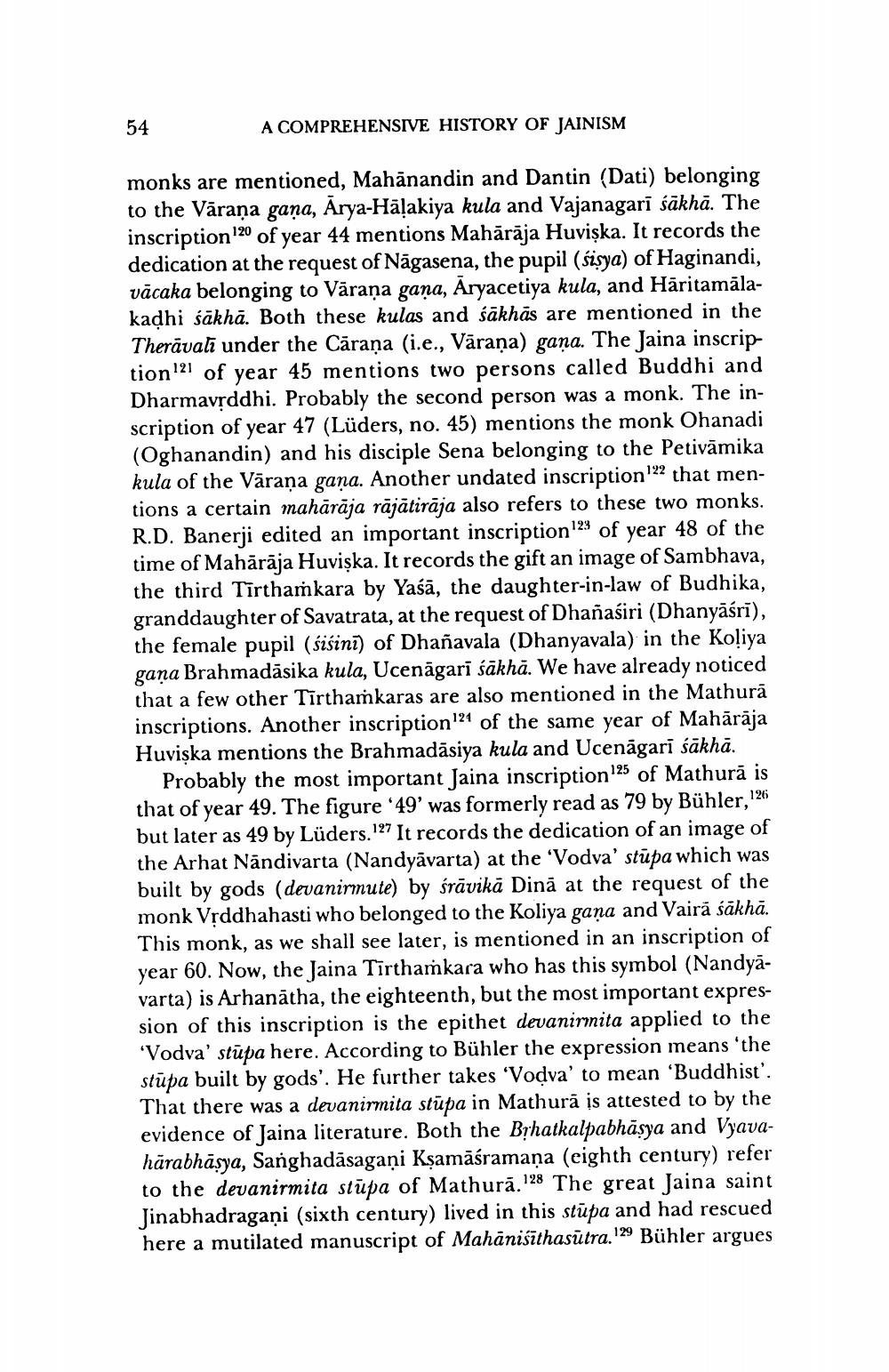________________
54
A COMPREHENSIVE HISTORY OF JAINISM
monks are mentioned, Mahānandin and Dantin (Dati) belonging to the Vāraņa gaña, Arya-Hāļakiya kula and Vajanagarī šākhā. The inscription '20 of year 44 mentions Mahārāja Huviska. It records the dedication at the request of Nāgasena, the pupil (śüsya) of Haginandi, vācaka belonging to Vāraņa gaña, Aryacetiya kula, and Hāritamālakadhi śākhā. Both these kulas and sākhas are mentioned in the Therāvalī under the Cāraṇa (i.e., Vāraṇa) gaña. The Jaina inscription121 of year 45 mentions two persons called Buddhi and Dharmavrddhi. Probably the second person was a monk. The inscription of year 47 (Lüders, no. 45) mentions the monk Ohanadi (Oghanandin) and his disciple Sena belonging to the Petivāmika kula of the Vāraṇa gana. Another undated inscription"22 that mentions a certain mahārāja rājātirāja also refers to these two monks. R.D. Banerji edited an important inscription 123 of year 48 of the time of Mahārāja Huviska. It records the gift an image of Sambhava, the third Tirthamkara by Yaśā, the daughter-in-law of Budhika, granddaughter of Savatrata, at the request of Dhanasiri (Dhanyāśri), the female pupil (śišinī) of Dhañavala (Dhanyavala) in the Koliya gana Brahmadāsika kula, Ucenāgarī sākha. We have already noticed that a few other Tīrthařkaras are also mentioned in the Mathurā inscriptions. Another inscription"21 of the same year of Mahārāja Huviska mentions the Brahmadāsiya kula and Ucenāgarī sākhā.
Probably the most important Jaina inscription 125 of Mathurā is that of year 49. The figure '49' was formerly read as 79 by Bühler, 126 but later as 49 by Lüders. 127 It records the dedication of an image of the Arhat Nandivarta (Nandyāvarta) at the 'Vodva' stupa which was built by gods (devanirmute) by śrāvikā Dinā at the request of the monk Vrddhahasti who belonged to the Koliya gana and Vairā sākhā. This monk, as we shall see later, is mentioned in an inscription of year 60. Now, the Jaina Tīrthamkara who has this symbol (Nandyavarta) is Arhanātha, the eighteenth, but the most important expression of this inscription is the epithet devanirmita applied to the 'Vodva' stūpa here. According to Bühler the expression means 'the stūpa built by gods'. He further takes 'Vodva' to mean 'Buddhist'. That there was a devanirmita stūpa in Mathurā is attested to by the evidence of Jaina literature. Both the Brhatkalpabhāsya and Vyava hārabhāsya, Sanghadāsagani Ksamāśramaņa (eighth century) refer to the devanirmita stūpa of Mathurā.128 The great Jaina saint Jinabhadragani (sixth century) lived in this stūpa and had rescued here a mutilated manuscript of Mahānisīthasūtra. 129 Bühler argues




